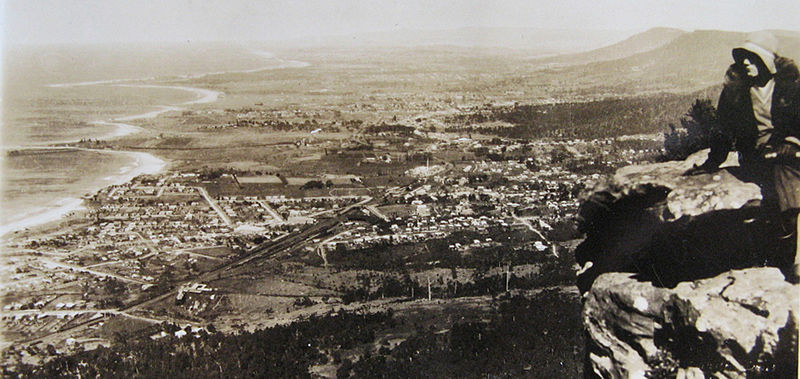In this guest post, ENGL3020 intern Emma Newman explores the story behind a first edition copy of D.H. Lawrence's Kangaroo held in the Fryer Library rare books collection.
D.H. Lawrence in Australia
As D. H. Lawrence travelled to Sydney from Perth in May 1922, he wrote to a friend, ‘I am not thinking of any work.’ However, one of the rare books in the Fryer library collection is the product of Lawrence’s stay in Sydney, and this work asserts itself as one of importance for Australian literature.
Kangaroo, published in 1923, tells the story of writer Richard Lovat Somers as he travels with his wife Harriet to Australia: he engages with not only its land, mining communities and their political movements, but reconsiders his European experience and the human condition. The parallels between Somers and Lawrence are in no way coincidental: Lawrence translated his experience into an Australian novel, a Thirroul novel, and a supranational novel.
Fryer's Kangaroo
The first edition of Kangaroo in the Fryer library was published by Martin Secker, an English publishing house named after its founder, in 1923. Lawrence was in correspondence with Secker throughout his travels, after the company began publishing his works in 1918. Whilst staying in Thirroul, a suburb of Wollongong, he wrote to Secker:
Am here in a house on the Pacific writing a novel – queer sort of quite different novel, pitched in Australia. … The new novel goes well, and I hope to call it Kangaroo and finish it by August. Unberufen! [ed: German for ‘touch wood!’] (Letters of D. H. Lawrence, p261)
Thirroul was not only Lawrence’s home away from home for a few months, but also bore similarities to his childhood in Eastwood, outside of Nottingham. It may have been a happy accident that Thirroul was an active part of the Australian coal mining industry from 1900 to 1962, but it would also have been an element of familiarity in Lawrence’s identification with the town. Wyewurk, the house where he and his wife Frieda lived from May to July 1922, has also been heritage listed by the state government because of his stay.

The Diggers Club
The Diggers Club, the facist paramilitary movement led by Benjamin ‘Kangaroo’ Cooley in the novel, was not completely invented by Lawrence. Based on the detailed scholarship by Joseph Davis and Robert Darroch on Lawrence’s movements around Australia, it is believed that while Lawrence did not leave 'Wyewurk' often he was aware of similar movements around the country. He also had exposure to these politics in Italy, where he travelled before coming to Australia.
In fact, it was not difficult for Lawrence to understand the Digger movements because of his own experiences with war: ‘The Nightmare’, the twelfth chapter of Kangaroo, is a reflection on Somers’ (and ultimately, Lawrence’s) experience of war time and politics. This experience is positioned as universal and communal, beyond geographic boundaries, and explains how an English person could become interested in an underground Australian-located movement:
It was the whole spirit of the war, the vast mob-spirit, which he could never acquiesce in. The terrible, terrible war, made so fearful because in every country practically every man lost his head, and lost his own centrality, his own manly isolation in his own integrity, which alone, keeps life real. (Kangaroo, p239)
D.H. Lawrence and Australian Literature
Kangaroo alone has had a profound influence on Australian culture, both literary and beyond. The novel’s treatment of the bush has been identified as a starting point for the Jindyworobak movement, a nationalist literary movement of the 1930s concerned with the landscape and attitudes towards colonialism. Garry Shead, a Sydney artist and Archibald Prize recipient, has completed both a painting and etching series based on Kangaroo and Lawrence’s stay in Thirroul. These works have been published as a monograph, as well as used for cover art for the 1989 and 1995 Imprint publishings of Kangaroo, the latter also illustrated with Shead’s etchings: these books are also available in the Fryer Library.
Lawrence is not considered an Australian voice in the same sense as Australian-born or Australian-identifying writers, but his contribution is one that should not be dismissed as merely an outsider looking in. Lawrence took the land and politics of early twentieth-century Australia and embraced it, in exchange creating a work that is a testament to Australian identity, community, and humanity.
Fryer's rare books
The Fryer Library's rare books collection encompasses subjects from Australian literature to zoology and time periods from the twelfth century to the present day. You can access Fryer's rare books collection in our Reading Room on level 4 of the Duhig Tower (Building 2) by appointment. All of our rare books are available to find and request in Library Search.
References
- Aldington, Richard. “Introduction.” Kangaroo, by D. H. Lawrence, Penguin Books, 1950, pp. 7-10.
- Darroch, Robert. D. H. Lawrence in Australia, Macmillan, 1981.
- Davis, Joseph. D. H. Lawrence at Thirroul, Imprint, 1989.
- “Garry Shead – Australian Galleries.” Australian Galleries, accessed 10 March 2020.
- Lawrence, D. H. Kangaroo, Martin Secker, 1923.
- Lawrence, D. H. The Letters of D. H. Lawrence, edited by Warren Roberts, James T. Boulton and Elizabeth Mansfield, vol. 4, Cambridge University Press, 1979.
- “Martin Secker: (author/organisation)” AustLit, 26 May 2014.
- “Thirroul.” Wollongong City Libraries, 16 April 2019.
- Wilde, William H., Joy Hooton, and Barry Andrews. "Jindyworobak Movement." The Oxford Companion to Australian Literature, Oxford University Press, 2005, accessed 10 March 2020.
- Worthen, John. “Lawrence, David Herbert.” Oxford Dictionary of National Biography, 25 May 2006.
- “Wyewurk.” NSW Environment, Energy and Science, accessed 6 March 2020.